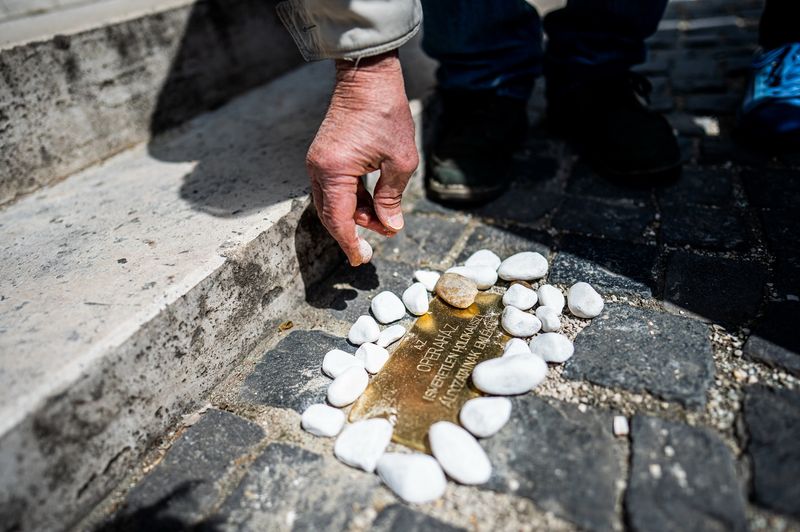
In memory of the victims of the Holocaust from the Opera House, seventeen Stolpersteine were inaugurated in front of the main entrance of the Opera House by Prof. Dr. Andor Grósz, president of the Federation of Jewish Communities in Hungary (Mazsihisz), and Dr. Szilveszter Ókovács, general director of the Hungarian State Opera.
At the event, Prof. Dr. Andor Grósz emphasized that the placement of the Stolpersteine conveys the message that the Opera House deeply values the contribution of its Jewish employees to Hungarian opera culture. “The memorial stones placed on Andrássy Avenue, one of the most prominent streets in the capital, can evoke names, faces, and stories for all passersby – locals and foreigners alike. Perhaps they also provoke reflection: What happened then? What is happening around us today? Where is the world heading?” – said the president of Mazsihisz.
Dr. Szilveszter Ókovács pointed out that the OPERA aspired to be a model and was indeed a societal model for high-quality, performance-based collaboration. It was from this ideal that antisemitism cruelly excluded people of Jewish origin, inflicting a deep wound on this ideal. “There was no racism in the OPERA either before or since, which we can be proud of, but this also points to our anger that 80 years ago, it still could happen. And everyone is affected, because we are all only one or two Stolpersteine away from a victim.”
Of the seventeen Stolpersteine scattered at the Opera House's main entrance – installed jointly by Mazsihisz and the OPERA – sixteen bear the names of victims, while the seventeenth commemorates the unknown victims of the Holocaust from the world of opera.
The sixteen named victims are:
- Rezső Abai (Abramovics), choir member – murdered in Auschwitz in 1944
- Miklós Bartos, opera singer – died in 1943 in Kyiv as a forced laborer
- Anna Bruckner, ballet dancer – murdered in Bergen-Belsen in 1944/45
- Gyula Fekete, violinist – died in 1944
- Lipót Földiák, accountant – murdered
- Zoltán Gallai (Goldstein), chorus member – died in 1942 in Novij Gran Hresztiki as a forced laborer
- Pál Hütter, cellist – murdered in 1943 as a forced laborer
- Leo Jotischky, violist – died in Gunskirchen in 1945 as a forced laborer
- Emil Kállai, violinist – died in 1944 during the Roma death march in Sopron
- Frigyes György Keleti, bassoonist – died in 1944 as a forced laborer
- Róza Kohlberg, opera singer – murdered in Auschwitz in 1944
- Emil Lichtenberg, conductor – murdered in Budapest in 1944
- Dávid Ney Jr., opera singer – died in Hörsching in 1945
- Antal Radó, literary translator – took his own life in Budapest in 1944
- Gyula Revere, harpist – murdered in Budapest in 1944
- Dezső Rovelli (Rosenfeld), chorus member – disappeared in 1943 as a forced laborer
The Stolperstein memorial project was initiated by German sculptor Gunter Demnig. The 10×10 cm brass plates embedded in concrete cubes and set into pavements honor the victims of National Socialism by marking their last freely chosen place of residence or – in cases such as the OPERA – their workplace, thus making historical remembrance both visible and tangible. Over the past thirty years, more than 100,000 Stolpersteine have been laid across Europe to draw attention to the inhumane crimes of Nazism.
Hungary's first Stolperstein was inaugurated in 2007, and since then, nearly 700 have been placed. The Hungarian State Opera is the first Hungarian theatre to commemorate its artists and staff lost during the Holocaust in this way, joining institutions such as the Komische Oper Berlin, the Hamburg State Opera, and the Salzburg Festspielhaus. The placement of the Stolpersteine is closely linked to another initiative of the Hungarian State Opera House, which is also unique in the Hungarian theater scene: the permanent exhibition titled “Shattered, abandoned, dead…”, opened in December 2022. It commemorates 83 members of the institution who were dismissed and persecuted due to their origins during the Holocaust. Curated by Márton Karczag, head of the OPERA Archives, based on the concept and primary research of stage director Sylvie Gábor’s doctoral dissertation, the exhibition is located in the basement of the Ybl Palace on Andrássy Avenue. The space also served as a shelter for many persecuted individuals during the siege of Budapest in World War II. The exhibition guide can be downloaded HERE.


